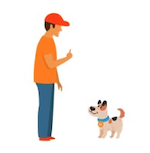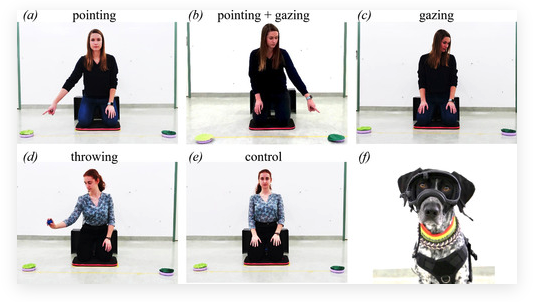
Scientists believe that they have figured out the best way to get your pet pal to pay attention to you.
There are plenty of strategies to train your dog, but is there a particularly effective method to get your dog’s attention? A team of scientists believes the most successful technique likely involves combining two tried-and-true signals—and they gathered data from canines strapped with eye-tracking headgear to back up their theory.
Dog owners frequently try communicating with their pets by looking or pointing directly at an object, but a research team at the University of Veterinary Medicine Vienna recently wondered if either method (or a combination of the two) would work best. In a study published this month in Proceedings of the Royal Society B: Biological Sciences, researchers introduced various communication scenarios to dogs in an attempt to learn the best answer.
The Study
While their test group originally included nearly 30 subjects, not every dog was willing to tolerate wearing the ski goggle-like eye-tracking headgear. So the study continued with 20 amenable  dogs consisting of eight mixed breeds along with four terriers, two Australian shepherds, two poodles, and a single collie, flat coated retriever, German shepherd, and Rhodesian Ridgeback.
dogs consisting of eight mixed breeds along with four terriers, two Australian shepherds, two poodles, and a single collie, flat coated retriever, German shepherd, and Rhodesian Ridgeback.
To evaluate the best human-to-dog strategy, a researcher first sat on their knees with a bowl on either side of them, only one of which contained a concealed treat. They then offered dogs fivedifferent scenarios repeated six times each: 1) pointing, 2) pointing and gazing, 3) gazing, 4) mimicking a ball throw, and 5) a no-cue control. Each dog’s eye movement was then tracked to record how often they followed the gestures, followed by whether or not they heeded the commands.
Results
Six dogs “performed significantly above chance” in the pointing-gazing condition, while three dogs correctly chose the treat bowl all six times during the pointing scenario. Conversely, none of the dogs performed noticeably above chance in the other conditions.
The study authors wrote “Our results show a clear difference in how dogs reacted to the directional but non-referential throwing cue compared with the referential hand gestures. While all cues including hand movements reliably prompted dogs to look to the side (unlike the referential gaze cue), only when presented with a pointing gesture did dogs redirect their gaze from the experimenter’s hand to the designated bowl.”
Despite the empirical evidence supporting the pointing-gazing combo’s efficacy, researchers stopped short of claiming dogs definitely understand their owner’s communication cues as we perceive them. “Is it for them more like an imperative directive to go somewhere? Or do they understand it more in a communicative way?”
Discussion
People and dogs have had a unique relationship for many thousands of years. What has been remarkable in this relationship is the way that dogs visually connect, even as very young puppies. Also highlighted in this relationship is the the way dogs can respond to human gestures like pointing and other body movements. The authors of this study suggest that more research needs to be done to better understand how our canine friends respond to our gazes versus our gestures like pointing. The use of eye tracking goggles in this study has begun to measure some of the aspects that visual information has and how important it may be in the canine understanding of what humans are asking or commanding them to do.
Future studies might focus on whether jointly attending objects or locations not only affects dogs’ gaze behaviour but also whether it affects their subsequent information processing and memory encoding. Mobile eye tracking could also be used in understanding other dog populations, including puppies and shelter dogs, to shed more light on their understanding of human referential communication. We know that dogs with varying levels of exposure to humans perform worse than pet dogs in studies of pointing comprehension. Finally, mobile eye tracking will provide information on how dogs with specific training backgrounds (such as guide dogs for the blind) respond to human communication and, more generally, how their attention differs from dogs without such specific training backgrounds.
Study [Link]
Völter CJ, Gerwisch K, et al. Using mobile eye tracking to study dogs’ understanding of human referential communication. Proceedings Of The Royal Society B: Biological Sciences. Published:12 February 2025. https://doi.org/10.1098/rspb.2024.2765
